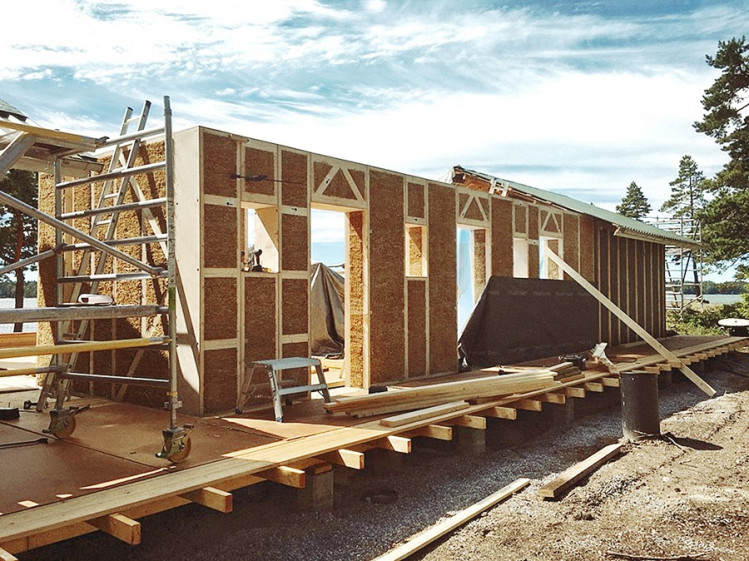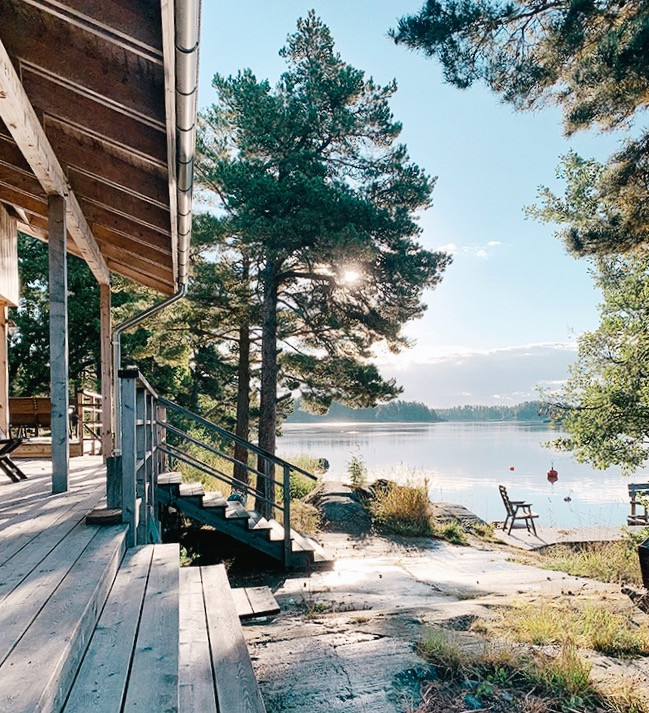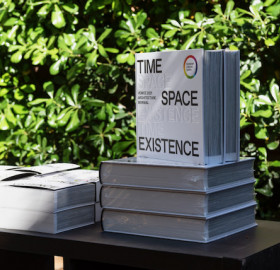Waves hit the steep cliff on an island in Finland's scenic Ingå archipelago. On a small hill around 70 kilometres west of Helsinki, stands Christian Hallberg's EcoCocon home looking proudly out across the sea.
But it wasn’t always that way. Imagine a leaky roof seeping into your walls, and problems adding up. Time passes and suddenly your home is on the verge of collapse, with something needing to be done desperately...
This is the journey of a home that was about to collapse, but today stands strong and sturdy, an endurable fortress on the fresh archipelago air.
What started as a problem became something extraordinary
The problems began in the 1980s and had been growing worse year by year. Christian’s grandfather built an original house himself in 1956. A second house followed on the same land, a 7-hectare island.
It seemed a bright idea at the time to join the new house with the older building. Without much ado, the two wings of the new house were joined to the original. Everything looked great.
But after the two constructions were connected, a new string of problems were invited in.
Scandinavia is certainly not immune to rain, and in between the joint of the two houses, water was beginning to leak inside. It was not an easy fix. Water was pouring in the walls and causing irreparable damage.
Initial ideas to only repair the leaking roof were soon discovered to be mighty optimistic.
“At first we only thought of repairing the roof, but it turned out that we had to rebuild the whole thing. The leak was so extensive that it’s a mystery that the house actually remained at all.”
An architect came in, who helped establish what could be done. As he was working, he spoke very warmly about straw houses, which seemed unusual to Christian.
“We had never heard of the concept at all and only knew about clay houses. But when you hear about something exotic like straw houses, you become really curious and want to know more. We got to visit EcoCocon. It only took five minutes to realise: this was definitely what we should go for. It turned out to be the right decision, especially for a home in the archipelago.“
This was the start of something completely new for Christian. His vision changed along the way, and in the end, adaptations were made to nearly the whole house.
This was, however, something he ended up being intensely glad about. What began as a problem requiring a solution, was soon being completely transformed into a project of extreme beauty.
“It ended with us completely blowing away the old house, leaving only the two wings at either end,” Christian says.
Going Inside
Knocking and entering, Christian takes us inside. We emerge into a truly open and bright living space, a centrepiece which makes up the middle part of the house.
Its impressively large windows gaze out to sea and the view is magnificent. But despite such large windows, the house is really well-insulated and cozy. Christian closes all the doors and windows to demonstrate, and it becomes impressively silent. As he lights up the hearth, it is so surprising to feel the home warm up so quickly.
The location is Finland, west of Helsinki, on an island called Barösund. Not a place known for warm temperatures.
But with five children (two of his own and three bonus ones) as well as three dogs, it’s important to keep everything smooth, snug and completely comfortable.
In Christian’s case, the project started as a means to fix a problem, but for most, it is a choice within the design stage. Straw houses are living houses which breathe. If moisture comes in, they dry quickly. Straw houses also harmonise with their environment. This is perfect even here, where the house is so close to the sea. The home is simply at one with nature: the dry air of the archipelago marries nicely with the natural materials to create a really pleasant indoor air.
As we step outside, we see that we are just about as close to the sea as you can get: it’s only eight metres from straw to water. A place where nature meets nature.
When he desires, he takes out a boat to Barösund with the family, to the 7-hectare large island. There are boat routes out, with one way taking five minutes and the other taking fifteen minutes, once they have reloaded what they need from car to boat. In the winter, when the sea has frozen properly, he can ride a snowmobile there. Then he can curl up in his little cocoon, as he calls it.
“Before, we heard the seagulls screaming outside, but we don’t even hear them anymore. If we close the door, it becomes completely silent,” says Christian, who also thinks that it insulates a little too well sometimes.
“By too well, I mean that if you light a cozy fire for too long during the summer, it will be almost too hot.”
A Warm Place
In the house sits an old-fashioned oven from Högfors Mill, alongside a newly built fireplace with a built-in baking oven and large water tank. The height of new Finnish combustion technology, it heats the domestic water at the same time as the fire crackles. It's fast.
The house also has natural ventilation, which means that the indoor air goes out through air ducts to be replaced by new fresh air entering through small holes in the building. The large stove heats the house, the domestic water and the sauna cabin.
As for the bathroom, the shower corner and sink have a tadelakt finish, which is an ancient method from Morocco. It uses a lime-based plaster mixed with olive soap and is polished with a natural or ceramic stone, which makes everything waterproof in the most natural way.
“Straw is an unbeatable natural material that has also changed my mindset. I’ve learned a lot about just how much the materials that are typically used can harm nature,” says Christian.
Christian works for Oceanvolt, a Finnish company that manufactures electrical motor systems for recreational boats. The company’s express aim is cleaning up boating life, so it was perhaps natural that he was drawn to a more ecological way of building.
The EcoCocon home was built directly on site by The Natural Building Company Oy (now SustainaBuild Oy). The design was a little more complex as it had to be adapted to fit the space between the wings, the building between the wooden wings taking a year and 3 months to be constructed.
On the inside, the walls are clay-lined in three layers, with different shades from white to terracotta, giving the house character and depth, using clay from Estonian company Saviukumaja.
The building also has no metal bars or bolts, since the beam that holds up the house uses drive nodes.
A Quick Map of the House
In the west wing is the master bedroom with its windows facing south, presenting a fantastic view of the sea. It is too cold to sleep in the winter, as this part does not have a straw construction.
To the west wing is the kitchen, also without straw insulation, which overlooks the south and southwest.
The building between the two wings is the newly built straw house. There are living areas, bedrooms, a sauna and bathroom.
On top of the house is its Rheinzink metal roof. This is made of titanium zinc, which does not rust due to the zinc having a purity level of 99% - ideal for a house in the archipelago.
Its base stands on a foundation of cast pillars, whilst the wings stand on cast sand-filled solid ground.
The outside of the house has wood fibre layers that allow it to achieve Passive House standard in a colder climate. The particular wood used is Finnstamm Heartwood pine.. This enabled it to withstand the harsh climate of the archipelago.
Into the Future...
As we leave this beautiful island, we are thankful to have had the unique opportunity to see first hand a sophisticated, traditional and inviting home, and one which I am sure will inspire others like it inspired us.
Importantly for Christian, he now has a warm, safe and secure home - watertight, of course - which provides the perfect atmosphere and comfortable living for the future.
Photos: Christian Hallberg, Tiina Tervo, and EcoCocon.
Based upon an original article by Nina Gergi in ‘Kloka Hem’, a Swedish magazine focusing on ecological building and interior design. It reports on environmentally friendly homes, and provides inspiration for living a sustainable lifestyle.













